
 |
Eager Space | Videos by Alpha | Videos by Date | All Video Text | Support | Community | About |
|---|
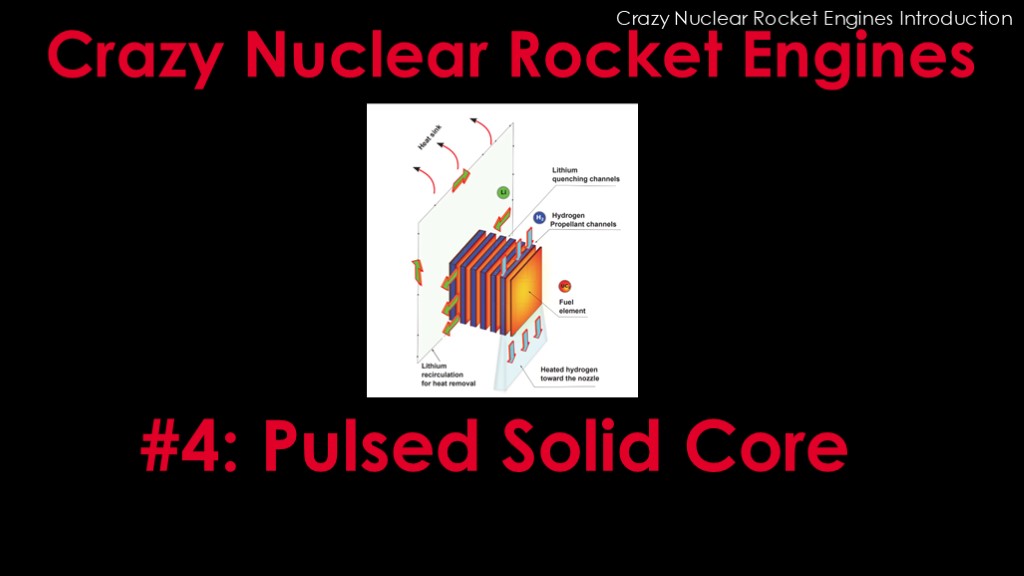
Welcome to Crazy Nuclear Rocket Engines Episode #4: Pulsed Solid Core
If you haven't watched the introduction video, please do that now.
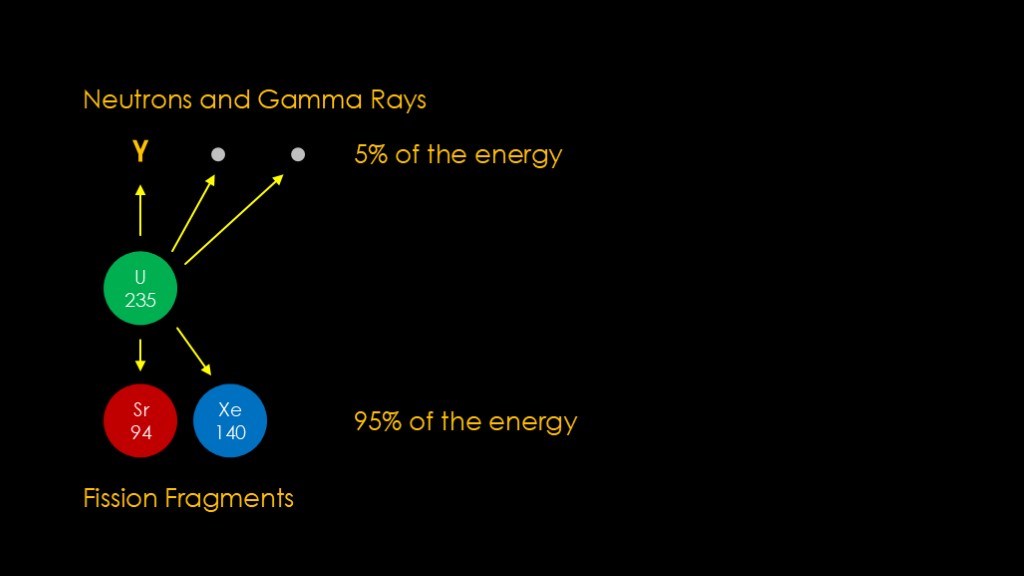
Expanding on the fission discussion in the introduction, when a uranium 235 atom splits, the are multiple products.
First, there are fission fragments, the new atoms that are made up from most of the mass of the uranium atom.
Second, there are fast moving neutrons that used to be part of the uranium atom and a high-energy gamma ray.
The fission fragments are moving very fast and therefore contain 95% of the energy that is created. That motion - or heat - is what heats up the nuclear core, and - if we get too much of it - what melts the nuclear core.
The neutrons and gamma rays contain 5% of the energy that is created, but it is energy that can travel outside the solid core.
The goal of the pulsed solid core is to harness that 5% to superheat the hydrogen to a higher temperature than the general temperature of the core.
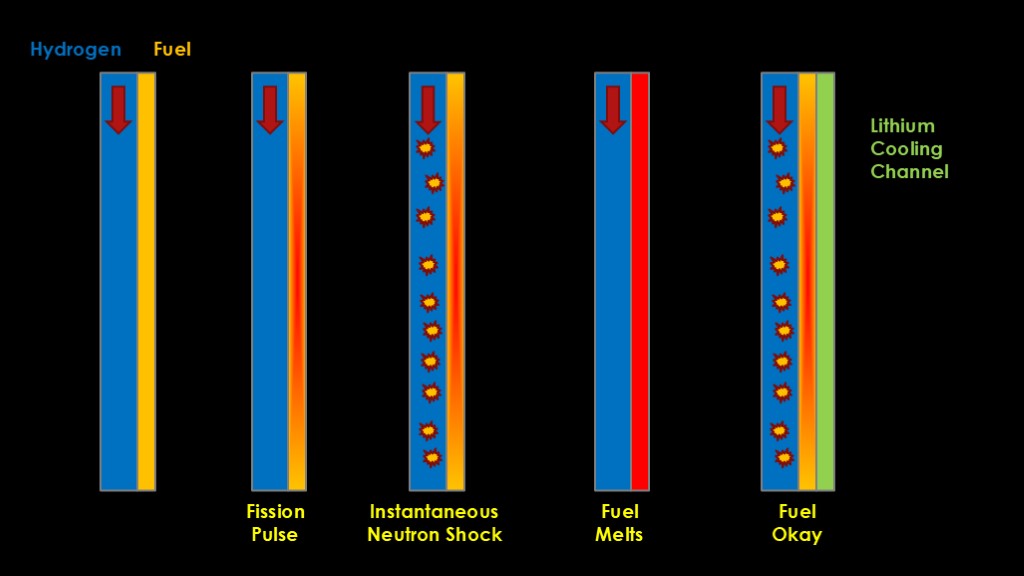
We start with a hydrogen channel that is right next to a thin vertical channel of uranium fuel.
We then use external means to increase the reactivity of the fuel, so it goes from very little fission to a large amount of fission quickly.
This generates a large pulse of neutrons, which travel into the hydrogen fuel and heat it up very quickly. Because we are heating by neutrons, we don't have the temperature limits that we had in the solid core design, so we can end up with much hotter hydrogen and therefore a higher exhaust velocity and specific impulse
Immediately after that pulse, the resulting heat pulse melts the fuel, destroying the engine. Which would seem to be a disadvantage.
However, what if we could put something next to the fuel to suck all the heat away, so that it wouldn't melt. It turns out that to conduct the heat away quickly enough, you need a material that is really good at conducting heat and has a reasonable melting point, so liquid lithium metal is the coolant of choice. The core sits idle until the lithium has pulled enough heat out of the fuel so it can survive another pulse.
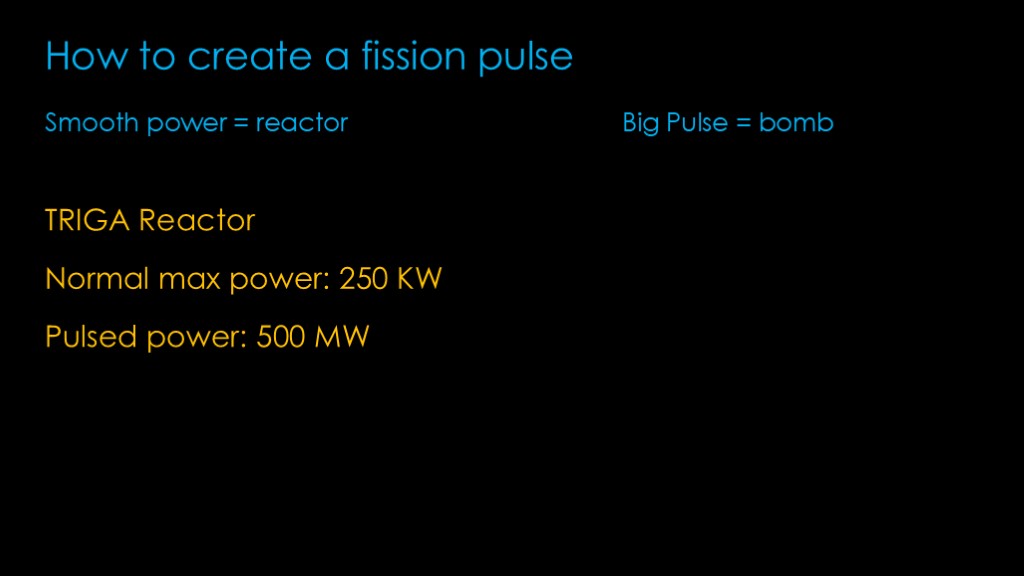
But how to create that fission pulse?
Generally speaking, the goal with a reactor is to slowly and smoothly increase the power of the reactor. If we end up with a big pulse of fission, that is generally a bad thing - less like a reactor and more like a bomb.
Interestingly, this is a solved problem.
There is a research reactor design known as TRIGA that is used at many universities. Normally, it's max power is only 250 KW and it typically runs at much lower power levels, but it can also operate in a pulsed mode.
This is a video of TRIGA operating in pulsed mode. Watch for the blue flash.
That blue flash is known as Cherenkov radiation, and it's directly a result of the fission pulse. This pulse was 500 megawatts, or 2000 times the normal maximum output. The loud noise is a control rod being removed or replaced in the core very quickly.

TRIGA accomplishes this by using a very specific Uranium Zirconium Hydride fuel.
When this fuel is cold, it increases the rate of fission
When it gets hot, it decreases the rate of fission.
That automatically creates a pulse about 40 milliseconds, or 1/25th of a second wide.
Triga pulse
https://ansn.iaea.org/Common/documents/Training/TRIGA%20Reactors%20(Safety%20and%20Technology)/pdf/chapter1.pdf
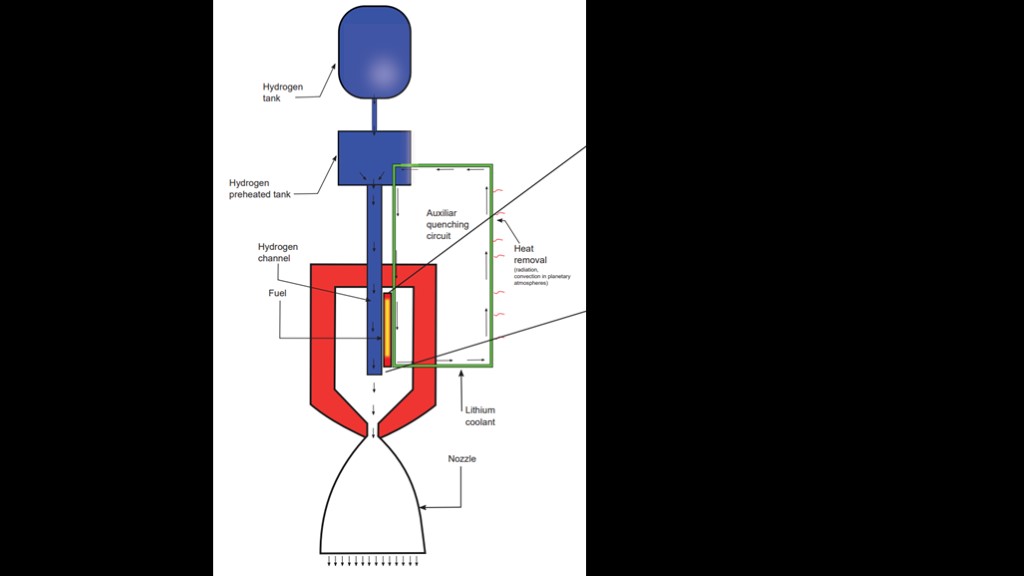
Here's a diagram of the overall propulsion system, which is just like a standard nuclear thermal rocket except for the lithium coolant loop to take the excess heat away.
There's a neat little trick to use some of the heat from the lithium to preheat the hydrogen before it goes into the reactor.
https://sci-hub.se/https://arc.aiaa.org/doi/pdf/10.2514/6.2016-4685
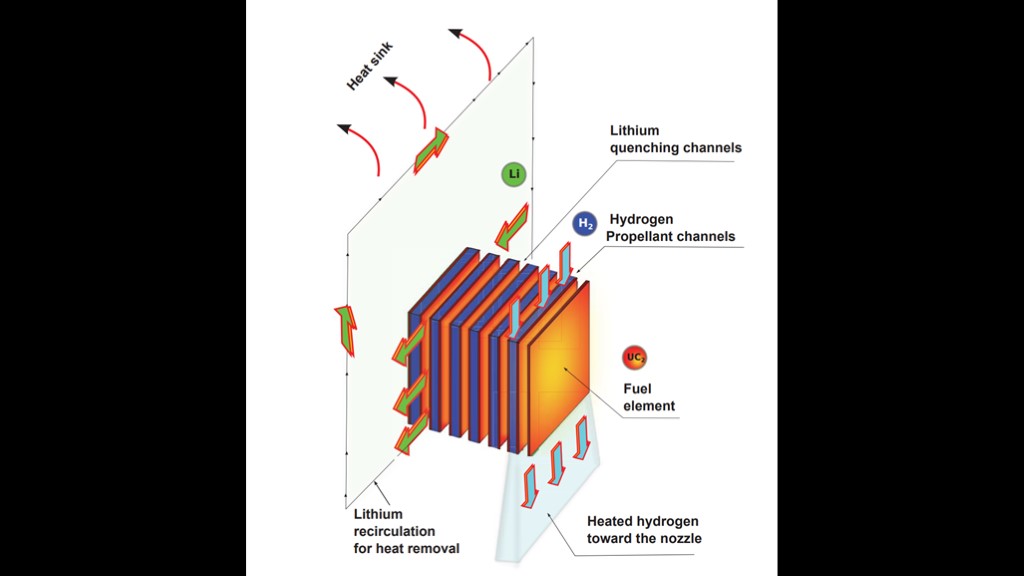
To get sufficient thrust out of this approach the core is arranged as a stack of flat plates of fuel with channels for the hydrogen propellant and the lithium coolant.
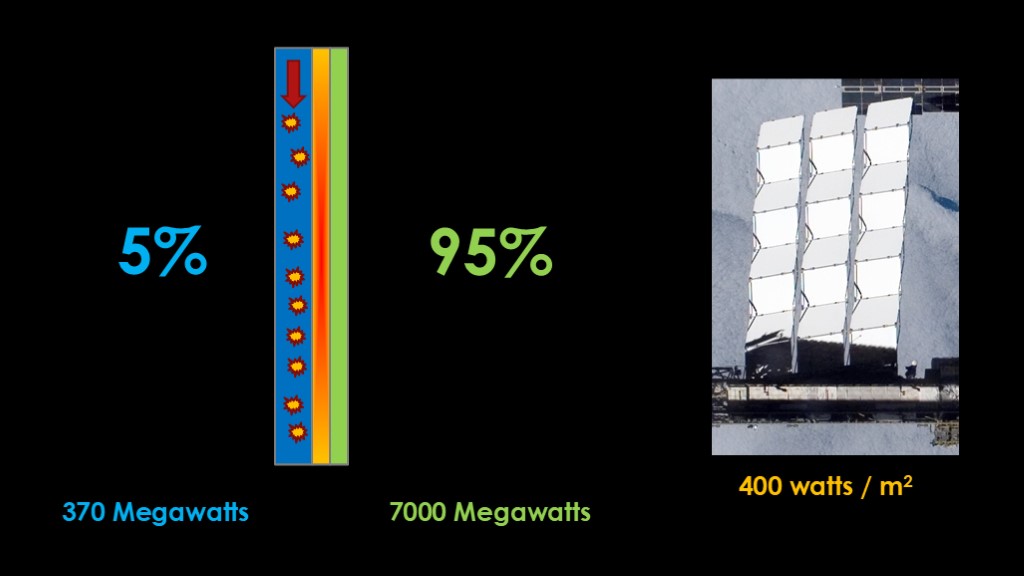
Let's talk about heat and power.
A smallish nuclear thermal rocket engine has a thermal power of about 370 megawatts. That suffices to give roughly the thrust of an RL-10 rocket engine.
That energy needs to come from the 5% of the fission energy that goes to neutrons and gamma rays.
The lithium cooling loop therefore needs to deal with 95% of the fission energy, or 7000 megawatts.
It's not quite that bad because we can use the hot lithium to preheat the hydrogen, but any energy we want to use to go above the non-melting core temperature can only come from the 5%.
That waste heat needs to be radiated away. Current satellite radiators - such as these on the international space station - can radiate about 400 watts per square meter.
7000 million divided by 400 is equal to 17 million square meters of radiator.
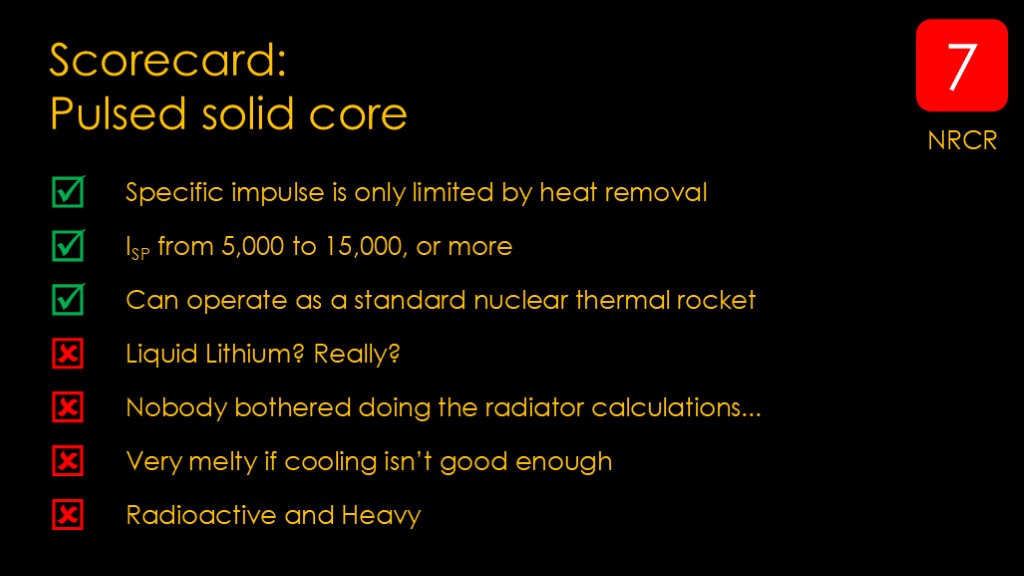
Here's a scorecard for the pulsed solid core
On the plus side:
The specific impulse is only limited by the ability to remove heat, and might reach 5,000 to 15,000, or perhaps more
It can operate as a standard nuclear thermal rocket.
On the downside:
Liquid metal coolants are very heavy, and you need to be able to liquify all of it at startup. You probably need a dual-loop system.
Heat isn't much of a problem in the standard nuclear thermal reactor because it mostly goes into the hydrogen propellant. Here you need to be able to get rid of 19 times the heat that goes into the propellant. It's simply not feasible.
If the cooling doesn't work exactly right, you end up with molten lithium, hydrogen, and very hot uranium mixing together. That has "core explosion" written all over it, and while it's not a nuclear explosion, it's not going to be kind to the rocket engine.
And, as usual, it's radioactive and heavy, especially heavy because of the lithium cooling loop.
I give this design a Nuclear Rocket Craziness Rating of 7.
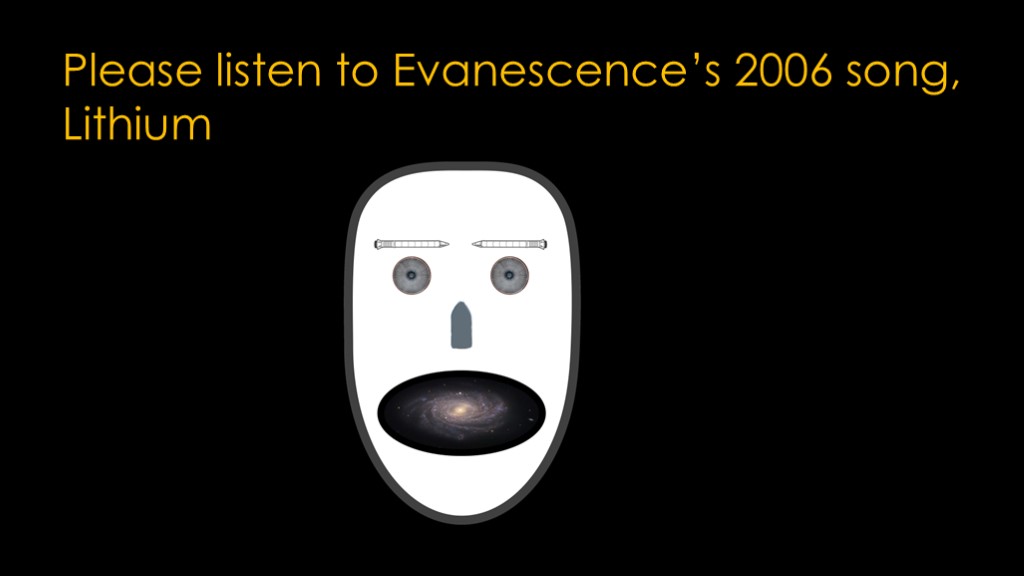
If you enjoyed this video, please listen to Amy Lee's haunting vocals on evanescense's 2006 song, Lithium